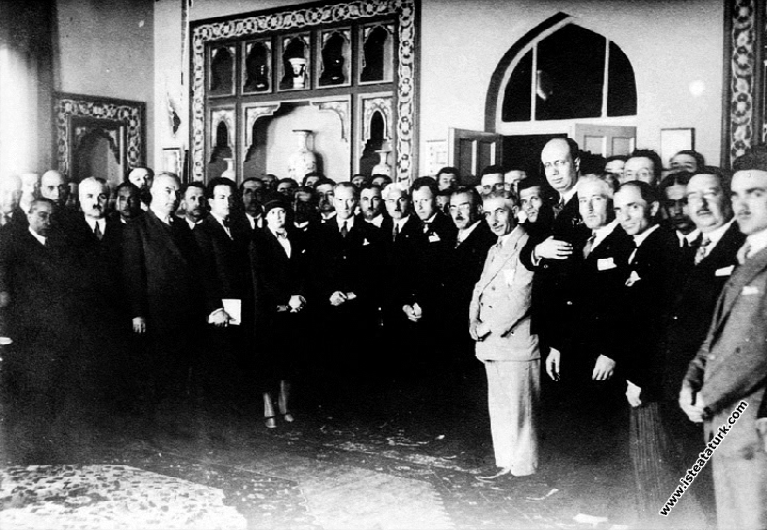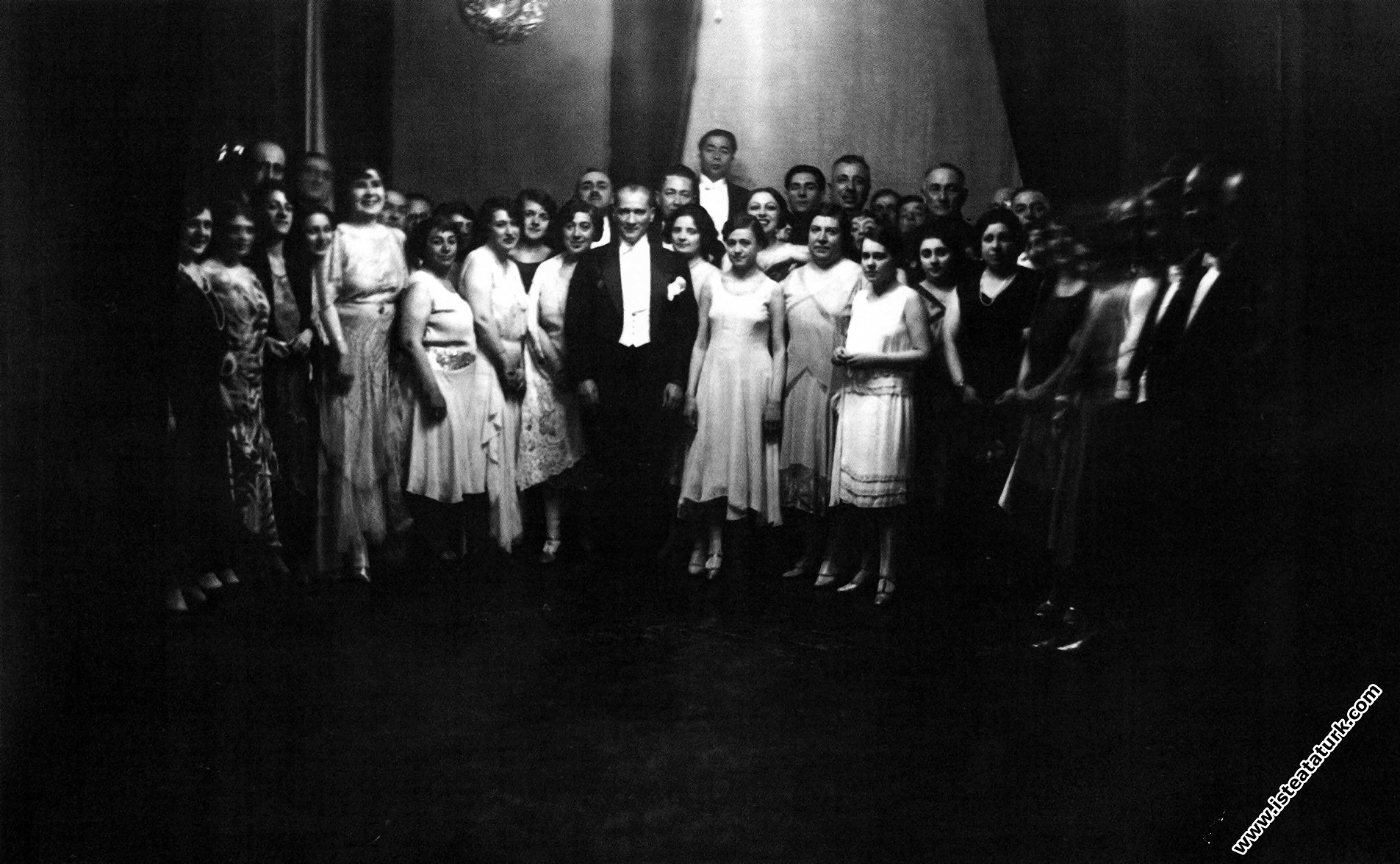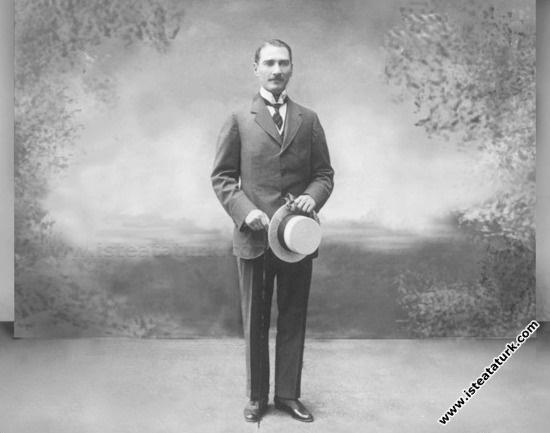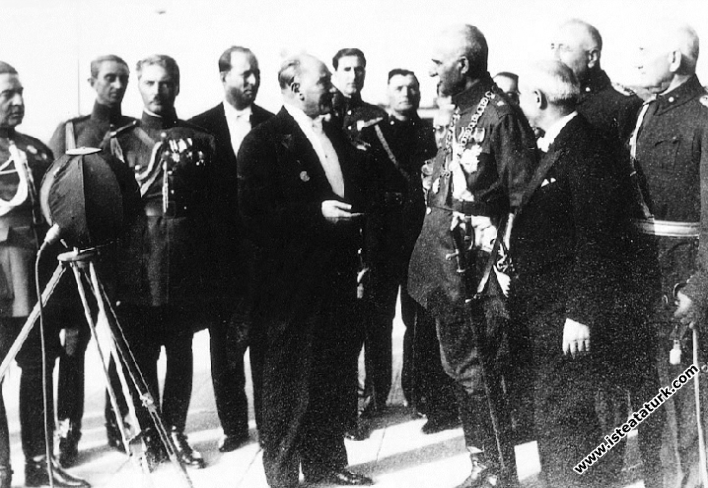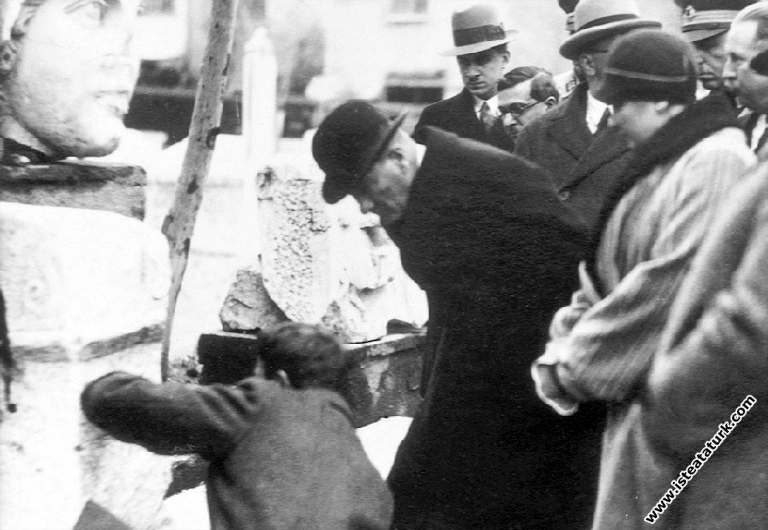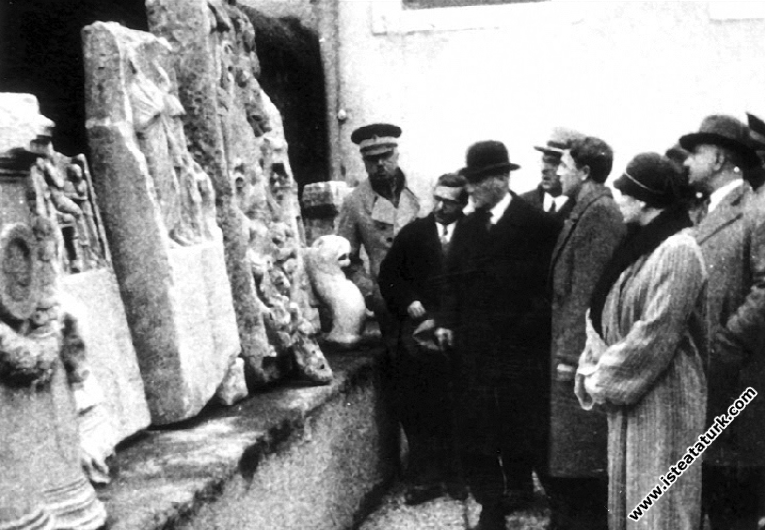
Atatürk and the Museum
Character Size
Atatürk and the Museum
ATATÜRK and MUSEUM
“Human intelligence, which is entering the mystery-filled chest of nature more and more every day, has found and determined sciences that will satisfy those who work in order to reach reality and enlighten the history of humanity. Archeology and Anthropology are at the forefront of those sciences. History becomes grounded as it is based on the documents found by these latest sciences. That's why every piece of our historical documents is a mirror of cultural works that are considered classics."
Mustafa Kemal Atatürk
In addition to carrying the mission of being the identity of a nation, museums are also places where the tastes, loves, thoughts, beliefs, behaviors and lifestyles of people who left civilizations to us are preserved and this heritage is carried to the future. In order to see the future, it is necessary to know the past, in other words, to build the future not only on the present, but also on the past, which can be achieved with museums that keep history alive and not forgotten.
The artifacts in the museums, on the one hand, carry the past to the present, on the other hand, it is the most effective tool that makes it impossible to write on historical documents. So that; Museums are the archive of history, the laboratory of history, and the library of history. Famous historian Prof. Bernard Lewis said, “It is very important to know the history in order to see the future. History is to a nation what memory is to the individual. A society that distorts its history is like a neurotic person, and a society that does not know its history is like a person who has lost their memory.
We see the first traces of museology, which started with collecting in our country as well as all over the world, in the 13th century in the Seljuk Period. They arranged the embossed artifacts belonging to every period they found around the fortification walls, which surround the mound where Old Konya is located, and which have no traces today, within the framework of an order. It is known that Late Hittite artifacts were collected around Kahramanmaraş Castle during the Dulkadiroğulları Principality (1339-1522). In the Ottoman period, precious artifacts, gifts and spoils obtained from wars were preserved in the treasury offices in the palaces.
In the 19th century, the foundations of Turkish museology began to be laid, and in 1846, the first museum was established in the Hagia Eirene Church in Istanbul by Tophane-i Amire Director Fethi Ahmet Pasha. Grand Vizier Ali Pasha (1815-1871) reorganized the museum and named it Müze-i Hümayun (Imperial Museum). First Irish Edward Goold in 1869, and then German Dr.PA Dethier in 1872 were appointed to the Museum Directorate and the museum was moved to the Tiled Kiosk.
Osman Hamdi Bey was appointed to the Museum Directorate in 1881 and a new era began for Turkish museology. In 1884, a new Asar-ı Atika Regulation was prepared and it was forbidden to take old works abroad. Osman Hamdi Bey had the Istanbul Archeology Museum built in the garden of the Tiled Kiosk, and during his reign, a museum was established in Konya in 1902 and in Bursa in 1904. After Osman Hamdi Bey's death in 1910, his brother Halil Ethem Bey was brought in. Halil Ethem Bey especially contributed to the development of Anatolian museums, Turkish-Islamic Arts (1914) and Istanbul Oriental Works Museum (1925) were established in his time.
In recent years, as a result of contemporary museology understanding and efforts, Turkish museology has come to compete with world museums. The Museum of Anatolian Civilizations was awarded the “Museum of the Year in Europe” in 1997 in the competition organized by the European Museum Forum (The European Museum Forum), as well as the Istanbul Turkish-Islamic Arts Museum-Honorable Mention, Istanbul Archaeological Museums-Council of Europe Special Award. , Bodrum Underwater Archeology Museum - Honorable Mention, Antalya Museum - Honorable Mention. This shows us the point that Turkish museology has reached. In the same competition, Sadberk Hanım Museum was awarded with Honorable Mention, Rahmi Koç Industry Museum-Special Museum Award, Edirne Health Museum was awarded with the Museum of the Year Award in Europe.
Turkish museology, whose numbers are increasing day by day with private museums as well as archeology and ethnography museums, has ceased to be cold places where only works are exhibited in its 160th year, national and international conferences, seminars are held for the education of the public, various social and cultural activities are organized, exhibitions are opened, scientific excavations and publications; It has become an educational and cultural institution that contributes to the promotion of our country.
"The way to own a homeland is to know the historical events that lived in that land, to know the civilizations that were born, and to own it."
Mustafa Kemal Atatürk
Historical buildings were generally used for the first museums of our republic. Here the aim was to maintain and protect the old building. Today, most of these museums serve in the buildings where they were first established.
Some of the museums established during Atatürk's time;
Ankara Anatolian Civilizations Museum-1921, Antalya Museum 1922, Sivas Museum-1923, Adana Museum-1924, Bergama Museum-1924, Topkapı Palace Museum-3 April 1924, İzmir Museum-1925, Edirne Museum-1925, Ankara Ethnography Museum-1925, Tokat Museum-1926, Konya Museum-1926, Amasya Museum-1926, Sinop Museum-1932, İzmir Museum-1925, Kayseri Museum-1929, Ephesus Museum-1930, Opium Museum-1931, Van Museum-1932, Hagia Sophia Museum-1934, Diyarbakır Museum-1934, Manisa Museum-1935, Tire Museum-1935, Çanakkale Museum-1936, Niğde Museum-1936, Tire Museum-1936, Istanbul Painting and Sculpture Museum-1937.
Even before the establishment of the Republic, Atatürk also mentioned museology, aimed to be at the level of the civilized countries of the world in the science of archeology, as in every field, and explained at every opportunity with the value he gave to history and culture that it is necessary to protect all cultural assets like title deeds, no matter what period they were created. So that; During the Battle of Sakarya during the War of Independence (23 August-13 September 1921), he believed so much that the War would result in victory and that a Republic of Turkey would be established within the borders of the National Pact, that 90 km from Ankara, the Sakarya Pitched War continued at full speed. , on the days when the cannons reached Ankara, in Ankara, When he ordered the establishment of an Eti museum, which forms the basis of the Anatolian Civilizations Museum, the occupation forces said, "We have established our museum, and we are coming as a nation. Both the past and the future of these lands can be explained by their desire to convey our message, which is a good example of how important museums are for the survival of a country.
In the memories of Arif Hikmet Koyunoğlu, the Architect of the Ethnography Museum, the first museum building of our Republic; “Atatürk visited them during the construction on a cold winter day, they offered Turkish coffee, looking at the white view of the Ankara Plain under the snow from the front door, turning the swamp where Atatürk Forest Farm is located today into a beautiful farm by afforestation, He tells that it would be very pleasant to sit under the dome of the museum and watch the view after him, and after he finished his work, he wanted to lie down under the coolness of this dome and rest against this beautiful view”. What a strange coincidence that before he finished his work, when his nation needed him so much, between 1938-1953, that dome was his eternal resting place.
“Writing history is as important as making history. If the writer does not remain faithful to the maker, the unchanging truth takes on a nature that will surprise humanity.”
Mustafa Kemal Atatürk
In the first years of the Republic, efforts were made to bring back the artifacts that were smuggled abroad, and the artifacts from the Sardes Excavation, which were preserved in the warehouses of Izmir High School, by the American Consulate after the August 30 Victory, before the Greek armies left Izmir, and the artifacts sent to the New York Metropolitan Museum by a ship. The works were brought back to the country in 1924 by the order of .
“If the past is unknown, the future is unknown. The past is the best example of building a modern state.”
Mustafa Kemal Atatürk
The importance of preserving the past of these lands can be understood from the fact that the first government, which took office on May 9, 1920, right after the opening of the Great Leader Parliament, wanted to compile ancient artifacts and establish new museums. For this purpose, the Directorate of Antiquities (Asar-ı Atika Directorate) is established under the Ministry of Education. This directorate is responsible for the protection of ancestral architectural works and ruins. The directorate, which also carried out the surveillance and administrative affairs of the Museum-i Humayun branches established in the provinces before, was transformed into the Asar-ı Atika Directorate, Hars (Culture) Directorate a year later, and its staff was further expanded. With a circular on November 5, 1922, it was requested to collect, inventory and establish new museums of Archaeological and Ethnographic artifacts, In the government program of 14 August 1923, Museology was handled with its wide dimensions. Established in 1923 at Atatürk's request, the duties of the Heyet-i İlmiye included the establishment of a national museum in Ankara, the immediate opening of the Turkish Ethnography Museum, and the revision of the Asar-ı Atika Regulation.
With Atatürk's directive, the decision of the Council of Ministers on April 3, 1924, decided to open the Topkapı Palace as a museum, and he closely followed the efforts to transform the Palace into a museum. Covering an area of 700,000 square meters with later additions made by Fatih Sultan Mehmet, the Palace was the administrative center of the Ottoman Empire for 400 years until 1855. During Atatürk's last visit in 1934, he wanted Piri Reis's map of America, which was in the library of the palace, not to be hidden, to be introduced to the world, and especially to be sent to America.
Atatürk, who visits historical places and museums at every opportunity, examines the restoration of the Sultan Ahmet Mosque in 1929 and wants the repair to be accelerated. Meanwhile, he sees the ruined state of Hagia Sophia. Its courtyard is operated as a plotted coffee house, and pigeons fly on its roof. By connecting the building to the Ministry of Education, he makes it a museum and says, “...We are making Hagia Sophia, which has always attracted the greed of the people of the people, as a museum and as a gift to the world of science…”. Hagia Sophia, which was built between 324-327 years, has been used as a church for 911 years and a mosque for 481 years, and has been serving as one of the museums with the most visitors since 1934.
The 9,000 square meter Crown Office of the Dolmabahçe Palace is allocated for the Istanbul Painting and Sculpture Museum, the first painting and sculpture museum in Turkey, established during his reign. Paintings and sculptures in places such as Ankara Community Center, Dolmabahçe Palace, Ministry of Education and TBMM are sent to the museum, which was opened in September 1937.
Atatürk also visited museums and ruins during his country tours and was personally interested in the establishment of many museums. In the telegram he sent to İsmet İNÖNÜ on February 21, 1931 during his Konya trip, “I reviewed the museums and ancient works of art and civilization in various places during my last research travels;
1-“Apart from Istanbul, I have seen existing museums in Bursa, Izmir, Antalya, Adana and Konya. Some of the artifacts that have been found so far are preserved in them and are partially classified with the help of foreign experts. However, in the future, the artifacts of ancient civilizations, which lie in the form of unique treasures in almost all parts of our country, are unearthed by us in the future, and they are sent to the Museum Directorates to be used in excavation works (Archaeology) specialists for the preservation and classification of the monuments, which have become very devastated due to the constant neglect of the past periods. i need it. For this reason, I think that some of the students who will be sent for collection other than Education will be suitable for this branch.” (Ekrem Akurgal, Sedat Alp, who was first sent abroad to study archeology with a state scholarship,
2-“Although they are in great ruin due to centuries of neglect in Konya, there are some treasures that can be counted as genuine architectural masterpieces of Turkish civilization eight centuries ago. Of these, the Karatay Madrasa, Alaeddin Mosque, and sahibinden Ata Madrasa Mosque are in need of immediate and personal repair. Since this repair will be delayed and cause the monuments to be completely destroyed, I request that the evacuation of the soldiers occupied and the repair of their cages under the supervision of special persons be ordered first." Kemal Ataturk.
The Great Leader, who devoted his whole life to his homeland and nation, thinks that culture is a state policy. He established the Turkish Historical Society on April 15, 1931 for the study and protection of all civilizations that lived in this land, and after him, a large part of his heritage was kept in research and excavations so that these works would not be interrupted. It leaves it to dry for use. In 1935, the President of the Turkish Historical Society Hasan Fehmi Çambel and Afet İnan, whom he invited to the Florya Mansion, had to take adequate measures for the collection, preservation and restoration of all kinds of cultural and archaeological documents, cooperation with the necessary institutions, sensitivity of the local environment, that only excavations would not be enough. In his 10-item order, which preserves its importance by restoring the finds, says:
1-To find, collect, preserve and restore all kinds of historical documents, materials and monuments.
2- To take all measures by the government in order to keep the historical monuments in the country and in a dispersed form free from the danger of being destroyed, stolen, sold, destroyed and destroyed by itself in time,
3- Under the close attention, follow-up and responsibilities of the government authorities and municipalities, with a continuous and tireless propaganda activity that will be opened to the Republican People's Party People's Houses and party organs, and under the supervision and monitoring of the General Directorate of Press and Publications, a continuous, effective, popular press will be made in daily newspapers and magazines. to be preserved by the Turkish people, who are the original owners of these national historical goods,
4-To create collections from copies of old works and paintings available in museums and libraries both inside and outside,
5-Collecting artifacts from certain periods and cultures in Ankara, Istanbul, Bursa, Izmir and Edirne, and turning these cities into centers of ancient artifacts and monuments in great style,
6-To carry out archaeological and anthropological researches and discoveries in order of excavations in small scales for the time being, in order to carry out the excavations that foreign historical expeditions have accomplished with large capitals, in the future, in the full time of our financial power,
7- Organizing trips to important excavation and discovery sites in and outside the country, conducting scientific investigations on the historical artifacts and monuments found,
8- Follow-up of the works of the government by the commissions responsible for implementing these projects,
9-To cooperate with foreign scientific institutions and authorities, experts,
10-Providing efficient assistance and cooperation of the Ministry of Culture.
The first of Atatürk's reforms right after the foundation of our Republic was the education reform. First, primary schools and high schools providing modern education are opened. There was only Istanbul University as a college, and that place could not provide enough education according to the conditions of the day. Atatürk wants archaeologists to specialize by being trained throughout the country. In the “New University Law” adopted on May 31, 1933, there are Archeology and History departments. In 1935, the Faculty of Language, History and Geography was established, and Archeology departments were opened in Ankara and Istanbul. We learn that Atatürk was interested in Turkish history and languages from the books he read during the War of Independence, from the books belonging to his private library in Anıtkabir and the notes he made on them.
On the one hand, while the “New Universities Law” was being prepared, on the other hand, students were being sent abroad. Meanwhile, Jewish scientists who fled from Hitler's rule in Germany (January 31, 1933) and scientists with a Jewish family were given the opportunity to work freely in these universities. While these scientists were training Turkish students in the fields of archeology, history and art history, the Turkish Government assumed the responsibility of protecting the incoming professors. Reşit Galip Bey, Minister of Education, who signed this agreement; “From now on, these individuals, whether they are free or in prison, have been taken under the protection of our Government by being considered as employees of the Turkish Government. The German Government will not cause them any difficulties. If it does, we know how to deal with them.”
“The Turkish Nation! is proud of its history, because your ancestors are an entity that established civilizations, created states and empires.”
Mustafa Kemal Atatürk
On the 10th anniversary of the Republic, National excavations started with the instruction of Atatürk. Atatürk especially wanted to investigate the Hittite Civilization near Ankara; Gavurkale 1930, Ahlatlıbel 1933, Karalar 1933, Çankırıkapı (Roman Bath), Etiyokuşu, 1937 Alacahöyük 1934, Pazarlı and Büyük Güllücek 1934 excavations, the Thrace Region researches that started in 1930 and the Hasankeyf survey that started in 1932 are some of the works that started with his directives. The first archaeologists, historians, art historians, philologists and anthropologists of the Atatürk Republic worked in these excavations. Since 1933, excavations have been started all over the country, especially in Çanakkale-Truva, Çorum-Boğazköy, Malatya-Aslantepe.
“History is the most accurate guide that shows what a nation is capable of achieving.”
Mustafa Kemal Atatürk
Atatürk visited the Berlin Museum and the Pastdam Palace and told the Director of Topkapı Palace Museum Tahsin ÖZ that he was very upset when he heard that the Pergamon Zeus Altar had impressed him and that he had been kidnapped from Turkey.
He visited the Alacahöyük, Gavurkale, Ahlatlıbel, Ephesus, Bergama and Aspendos Theaters on various dates, and during his visit to the Aspendos Theater during the Emperor Marcus Aurelius Period (161-180 AD), he wanted the theater to be restored and opened to cultural activities.
Today, the Ministry of Culture and Tourism of the Republic of Turkey, which accepts the level of development of museums and museology as the criterion of the modernity of countries; It counts the cultural heritage on these lands, no matter what date it was left by, among its main duties to carry it to the future with the awareness of protecting the universal values of humanity.
“Today the Soviet Union is our friend, our ally. We need this friendship. But no one can predict what will happen tomorrow. Just like the Ottoman Empire, just like Austria-Hungary, it can crumble and crumble. The nations that he holds tightly in his hands today can escape from his palms. World may reach a new balance. Here, Turkey should know what to do... Our brothers and sisters of one language, one faith and one essence under this friendship administration, we must be ready to take care of them. Being ready is not just being silent and waiting for that day. You need to be prepared. How do nations prepare for this? By keeping spiritual bridges intact. Language is a bridge... Faith is a bridge... History is a bridge. We must go down to our roots and integrate into our history, which is divided by events. We cannot wait for them to approach us. We need to approach them.”
Mustafa Kemal Atatürk
1933 Çankaya Mansion
Source
1-A.Inan, Memories and Documents About Atatürk, Ankara, 1969
2-A.Inan, What I Wrote From Mustafa Kemal Ataturk. National Education Press, Istanbul, 1971
3-Atatürk's Words on Culture and Civilization, Atatürk Culture, Language and History High Institution Atatürk Cultural Center Publication 37, Ankara, 1999
4-S. Karagöz, Idol Magazine, Issue 2, pp.22-24, 1999
5-F.Geylik, Turkish Museology, Ministry of Culture Publications, Ankara, 1999
6-Reşit Galip, Journal of Turkish History, Archeology and Ethnography 1, Istanbul 1933
7-D.Live, Principles of Kemalism, Ankara
8-Ankara Magazine, Volume 1, Issue 2, Ankara, May 1991
Melek YILDIZTURAN
Archaeologist, Museum of Anatolian Civilizations
Source: www.kultur.gov.tr
